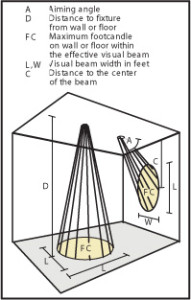Lighting Design
 There is much confusion between the concepts of quantity and quality in the field of lighting design. Although interrelated, these two items are distinct. The quantity of light can be physically measured using a light meter and other equipment. However, a light meter can’t duplicate the sensitivity of the human eye – there may be a significant difference between what a light meter reads and what the eye perceives. The quality of light is a perception that changes as a result of personal experience and aging. A good lighting design takes quantity and quality into account and strikes a balance. The type of source used is also essential in providing a successful lighting design. We will suggest the correct locations to use metal halide, high pressure sodium, compact fluorescent, fluorescent, incandescent, and low-voltage light sources. The following represents the process we undertake in a typical lighting design project.
There is much confusion between the concepts of quantity and quality in the field of lighting design. Although interrelated, these two items are distinct. The quantity of light can be physically measured using a light meter and other equipment. However, a light meter can’t duplicate the sensitivity of the human eye – there may be a significant difference between what a light meter reads and what the eye perceives. The quality of light is a perception that changes as a result of personal experience and aging. A good lighting design takes quantity and quality into account and strikes a balance. The type of source used is also essential in providing a successful lighting design. We will suggest the correct locations to use metal halide, high pressure sodium, compact fluorescent, fluorescent, incandescent, and low-voltage light sources. The following represents the process we undertake in a typical lighting design project.
Preliminary Design Concepts
The preliminary design involves meetings and discussion of concepts, working directly with you and your client to determine the desired atmosphere of a space and use all the available information regarding possible colors, textures, and finishes to simulate the outcome. In this way, we can more accurately develop the characteristics a lighting solution will have for a particular space. We also make recommendations on types of colors and finishes to use to maximize the illumination effects within a space. This can result in significant luminaire reduction, saving your client initial and operating costs. The preliminary design is then transferred to a CAD drawing and plotted for review and revisions as required. Once the design concept is fixed, the luminaire selection process begins and a fixture is chosen based on its aesthetics and performance characteristics. This stage forms the qualitative aspects of the lighting solution.
Lighting Design Calculations
After the preliminary design is reviewed and the qualitative concepts are fixed, we proceed to the calculation phase to ensure that the illumination levels and uniformity comply with accepted standards and recommendations of the Illuminating Engineers Society of North America (IESNA). We use a variety of software packages depending on the type of application and output required. This can be a very time-consuming process and is well-suited to computers. A calculation can take from 30 seconds to 30 minutes or more on a 400MHz Pentium II computer depending on the complexity of the design. When the illumination levels or uniformity are unacceptable, the lamp source wattage and/or reflector combination and/or locations of the luminaries is altered and the calculations are executed again and again until the desired results are achieved. The calculations may involve vertical illumination values as well as horizontal components where light-trespass and glare are factors in the design. This forms the quantitative aspect of the lighting solution.
